Treasures From the House of Alba 500 Years of Art and Collecting
Drawn from ane of the oldest and most significant private collections in Europe, Treasures from the Business firm of Alba: 500 Years of Art and Collecting features works by Goya, Murillo, Rubens, Titian, and more from the excellent palaces of the Alba dynasty in Spain. Co-organized by the Meadows Museum and the Casa de Alba Foundation, the exhibition brings together more than 130 works of art dating from artifact to the twentieth century. This is the starting time major exhibition outside Kingdom of spain of works from the collection of the Business firm of Alba—a prominent Spanish noble family unit with ties to the monarchy since the fifteenth century.
Highlights include masterpieces of Dutch, Flemish, German language, Italian, and Spanish painting, such as Francisco de Goya's The Duchess of Alba in White and Leandro Bassano's recently conserved Forge of Vulcan. A map by Christopher Columbus volition exist on display, along with his list of the people who accompanied him on the Santa Maria on the 1492 Journey of Discovery. Prints and drawings, sculptures, letters, illuminated manuscripts, decorative objects, and tapestries provide farther insight into the role of the Alba family in world history.
From the Gallery Guide
Treasures from the House of Alba: 500 Years of Fine art and Collecting presents more than than 130 works of fine art belonging to one of the most prominent noble families in the political and cultural history of Spain. The House of Alba traces its history back to the Middle Ages and, through commissions, acquisitions, and dynastic marriages, its dukes and duchesses have assembled what is among the most impressive private collections in Europe. The drove features masterpieces of Spanish painting, but its telescopic is in fact European art from artifact to modernism and includes historical documents. It therefore tells a story that extends beyond Espana to include many cultural developments that have shaped Europe. From Renaissance Italia to the Historic period of Exploration, and from the ladylike splendor of the Baroque to the high ideals of the Enlightenment, the Alba collection offers a window into European history. This guide calls attending to exhibition highlights and discusses how they reflect their specific cultural moments.
The Italian Renaissance
In the medieval menses, artists were considered skilled tradesmen and were subject to the aforementioned guild system that organized occupations such as weavers and carpenters. During the fifteenth and sixteenth centuries, the period of the Italian Renaissance, artists began to identify themselves equally a unique class of craftspeople. Innovations such every bit linear perspective, which employs mathematics and eyes, aligned artists with the sciences, every bit did practices such as closely studying human beefcake. At the same time, narrative paintings of scenes from classical antiquity, such as Leandro Bassano's The Forge of Vulcan, and biblical subjects highlighted their affinity with historians and poets.
A painting by Titian (ca. 1488–1576) and his workshop fulfills the Renaissance concept of istoria, which held that artists should vividly convey historical and biblical subject matter through dynamic compositions, gestures, and a mastery of illusionism. The Last Supper appears to take identify within a believable space. The lines of the room's tiled flooring are angled toward a single indicate on the horizon, underscoring the grid structure employed past Renaissance artists to create the advent of depth. Titian's abilities every bit storyteller and dramatist are too evident. He places xi of the twelve apostles on i side of the table with Christ, emphasizing their solidarity as a group. The lone figure seated opposite is Judas Iscariot; he holds a bag filled with silver, an indication that he has already betrayed Christ. The other apostles express a range of emotional responses to Christ'south pronouncement that one of them will betray him, adding pathos to the familiar biblical scene.
The Age of Exploration
In 1486, the Genoese navigator Christopher Columbus (1451–1506) first presented his case for a voyage of discovery, with the goal of finding an all-water route to the East Indies, to the Spanish monarchs Ferdinand (reigned 1474–1516) and Isabella (reigned 1474–1504). It took eight years, 2 more regal audiences, the intervention of a priest, and the fear that another court might hire Columbus for its own exploratory voyage to convince the king and queen to requite Columbus the requested ships and supplies. The rest is a familiar story. On Oct 12, 1492, later two months and eight days at sea, Columbus's crew spotted state on the western horizon and claimed information technology for Spain. Columbus's journeying touched off the Age of Exploration, during which major European powers vied for territory and mercantile reward in the New World. The riches that poured in after the conquest and colonization of the Americas made Spain a global superpower, and the following century would come to be known as Espana's Siglo de Oro, or Golden Age.
The dukes and duchesses of Berwick and later of Alba take been the custodians of the most pregnant documents related to Columbus'southward voyage ever since one of his descendants married into their family unit in the early eighteenth century. On view is Columbus's list of the people who accompanied him on his journeying, which has allowed historians to proper name the forty men and cabin boys who made the historic trip, and a certificate that is believed to be Columbus'southward travel diary. It contains a drawing of the coastline of the isle of La Española (Hispaniola, now occupied by Haiti and the Dominican Republic), which may exist the first map of a identify in the Americas fatigued by a European. A royal social club signed by Ferdinand and Isabella in 1494, appointing Columbus "admiral, viceroy, and governor of the islands and firm footing of the Oceanic Bounding main," is also included. Columbus was eventually dismissed from his postal service every bit governor and briefly jailed for his disagreements with the Spanish crown over his proper office in the colonies, but the documents attest to his pivotal part in establishing extended European contact with the New Globe.
The Reformation and Counter-Reformation
In 1517, a High german friar named Martin Luther (1483–1546) nailed his ninety-five grievances against the Catholic Church to the door of the Wittenberg Cathedral, setting in motion the Protestant Reformation and a period of religiously motivated wars that lasted into the eighteenth century.
From1477 until 1609, the Low Countries (present-day Belgium and the Netherlands) were part of the Spanish Empire. In 1567, Male monarch Philip II of Espana (reigned 1556–1598) sent the 3rd Duke of Alba, don Fernando Álvarez de Toledo (1507–1582), to Flanders to quash a rebellion of Protestants and restore guild and religious unity in his territory. The duke'southward harsh suppression of the Protestants earned him the moniker The Iron Duke, and he became a symbol of Catholic repression and violence. An allegorical statue in the Alba drove features a ophidian with the faces of the Spanish king's enemies, including the queen of England, the pope, and the elector of Saxony (a leader of Germany and a protector of Lutheranism); the duketries to keep the monster at bay with his staff. Ultimately, he was not successful in stamping out the uprisings in the Depression Countries. In 1581, the northern region alleged its independence as the Dutch Republic, while Flanders in the south remained under Spanish control.
Paintings in the Alba collection demonstrate the contrasting developments in the visual arts in Catholic and Protestant countries during the Reformation and Counter-Reformation. The Old Man and the Maid, by Flemish artist David Teniers the Younger (1610–1690), represents the type of secular genre scenes that appealed to the rising Protestant middle classes in northern Europe. The Crowning with Thorns, by Spanish artist Jusepe de Ribera (1591–1652), exemplifies the type of dramatic religious subject field matter that Catholic patrons deputed. Ribera was a follower of the Italian Baroque creative person Caravaggio (1571–1610). The dramatic lighting and bold diagonal composition of this painting are characteristic of the kind of theatrical yet naturalistic fashion that the Catholic Church building favored in this period.
Baroque Magnificence
In the seventeenth century, European monarchs competed to bring a handful of famous artists to their courts to paint their portraits and decorate their palaces. The art of the Baroque flow is virtually often described as bold, ornate, and expressive, but at its core it is art in service of royal magnificence. The dandy kings of the era used grand portraits to create an impressive public image that helped to justify their right to dominion in absolute terms.
The Alba collection contains works by Baroque masters connected to the court of King Philip Iv of Espana (reigned 1621–1665). Two of Philip's ancestors, Holy Roman Emperor Charles V (reigned 1516–1556) and Empress Isabella (reigned 1526–1539), are depicted past the Flemish artist Peter Paul Rubens (1577–1640) in a double portrait that captures the Bizarre taste for sometime and new. The painting is Rubens's interpretation of an before portrait by Philip'southward favorite Italian Renaissance painter, Titian, that is now lost. More than a mere copy, the portrait of Charles and Isabella demonstrates how a great seventeenth-century master studied and adapted the aesthetic of a major master who came before him.
As well on view is a 1653 portrait of Philip IV'southward daughter, Infanta Margarita, by the Spanish artists Diego Velázquez (1599–1660) and Juan Bautista Martínez del Mazo (ca. 1611–1667); Velázquez would later on feature the princess and her ladies-in-waiting in Las Meninas (1656), the masterpiece housed past the Museo Nacional del Prado in Madrid. Another highlight of the exhibition is a dashing equestrian portrait of the king's brother, the fundamental infante Ferdinand of Austria. Painted by the Flemish artist Gaspar de Crayer (1582–1669), it exudes Baroque glamour.
Two Women of the Enlightenment
Doña Mariana de Silva Bazan y Sarmiento (1740–1784) married into the Alba family in 1760 and apace found that she had an ally in her interest in art and literature in her new father-in-constabulary, don Fernando de Silva y Álvarez de Toledo (1714–1776), 12th Duke of Alba. The 12th duke served as ambassador to the French courtroom of King Louis 15 (reigned 1715–1774), which meant that he spent much of his time in Paris, the centre of the intellectual revolution known as the Enlightenment. There he befriended some of the eighteenth century's greatest figures, including the philosopher Jean-Jacques Rousseau (1712–1778) and the writer Voltaire (1694–1778). Both championed individual liberty and rational idea. A letter from Rousseau is in this exhibition.
In 1766, Mariana was admitted into the Royal University of San Fernando, an establishment that taught painting, drawing, and sculpting and administered annual exhibitions. She later became its director, an unusual part for a woman of the period. A portrait of her by the German language painter Anton Raphael Mengs (1728–1779), an important figure in the revival of neoclassicism during the Enlightenment period, captures her directly gaze and intelligent countenance.
Mariana's daughter, doña María del Pilar Teresa Cayetana de Silva y Álvarez de Toledo (1762–1802), 13th Duchess of Alba, was immortalized in pigment by another of the Enlightenment's nigh prestigious artists, Francisco de Goya (1746–1828) of Kingdom of spain. Like her mother and grandfather, Cayetana was intellectually curious and artistically adventurous. Her grandpa taught her philosophy and foreign languages at domicile rather than sending her to a convent school, and equally an developed, she surrounded herself with artists and scholars.
Goya painted the duchess many times, and their close friendship has sparked rumors of intimacy that take persisted through the centuries. On the cover of this guide, the duchess wears a white gown; its high empire waist and graceful simplicity reflect the vogue for classical artifact in the late eighteenth century. The dress is ornamented with a vivid cherry-red sash and bow and complemented past a coral necklace, as well equally matching bows in her pilus and on her dog. The duchess's expression is i of self-possession and firmness, nonetheless she seems natural and unconstrained, displaying none of the obvious trappings of social status. This tension between apparent ease and strong will makes information technology a portrait not just of one woman but of the character of the Castilian Enlightenment.
The Firm of Alba in the Twentieth Century
Don Jacobo Fitz-James Stuart (1878–1953), 17th Duke of Alba, and his daughter, doña María del Rosario Cayetana Fitz-James Stuart y de Silva (1926–2014), 18th Duchess of Alba, steered the Alba family unit through the twentieth century, expanding and protecting the family unit'due south cultural legacy and art collection. The knuckles acquired portraits of his historically significant ancestors and Old Master paintings related to the Spanish monarchs they had served. Cayetana expanded the Alba collection into new territory by adding French Impressionist paintings.
Both father and daughter were painted by the Spanish artist Ignacio Zuloaga (1870–1945). The fine art historian María Dolores Jiménez-Blanco has noted that Zuloaga was viewed past certain international collectors and critics in the first one-half of the twentieth century "as a modern merging of Velázquez, Goya, and El Greco." His affinity for defining a particularly Spanish artful steeped in fine art history made him perfectly suited to capture Jacobo and Cayetana every bit members of a modern family with a very old name.
Zuloaga'south depiction of Cayetana combines the most prestigious, traditional portrait type, the equestrian portrait, with the markers of a twentieth-century childhood. Cayetana sits astride a gentle-looking pony in a grassy field with a collection of toys and the family unit dog. The inclusion of Mickey Mouse in the foreground is one of the earliest representations of Disney's iconic grapheme in fine art. This melding of classical portraiture conventions and pop civilisation perhaps presaged something of the 18th duchess's vivacious character. While she maintained her part as the figurehead of one of Spain's most distinguished families, she was too known for her dearest of lively Spanish entertainments such every bit bullfighting and flamenco.
Today, Cayetana's eldest son, don Carlos Fitz-James Stuart, 19th Duke of Alba, continues his family'southward legacy of collecting and is the guardian of the House of Alba's treasures for future generations.
Megan Robertson, acquaintance curator of interpretation
The exhibition was co-organized by the Meadows Museum and the Casa de Alba Foundation. A generous gift from The Meadows Foundation made this project possible.
This exhibition is supported by an indemnity from the Federal Council on the Arts and the Humanities.
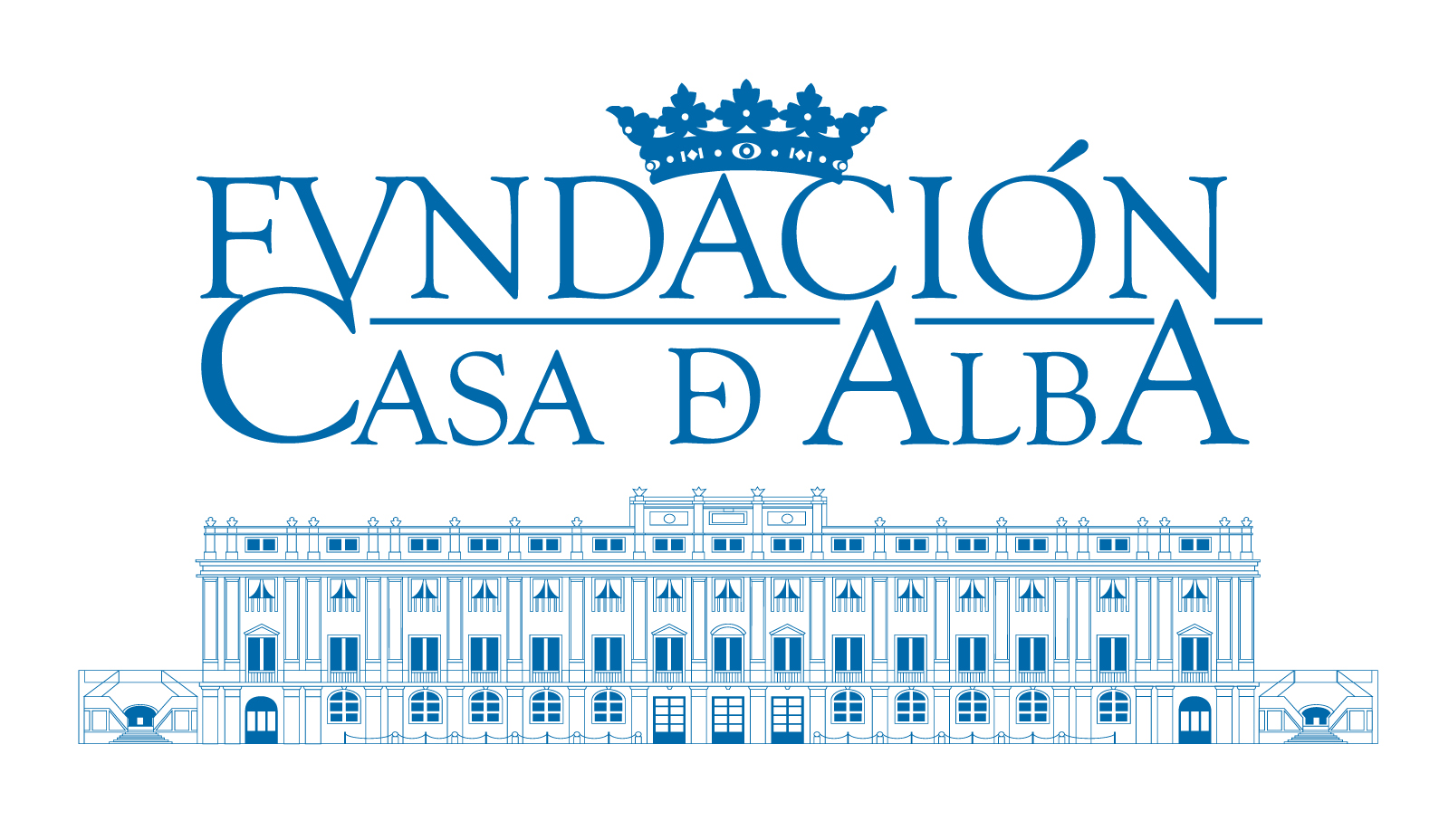
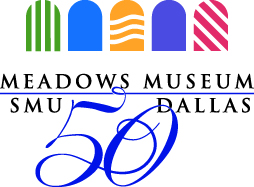
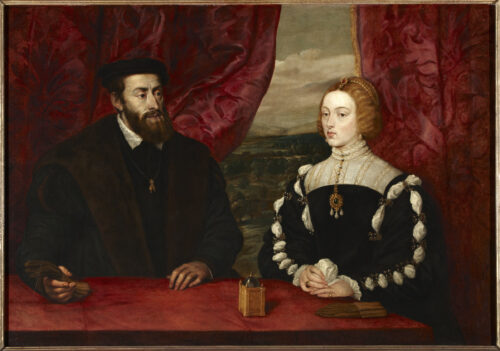
Peter Paul Rubens (Flemish, 1577–1640). Double Portrait of Charles Five and Empress Isabella, ca. 1628. Oil on canvas, 44 15/16 10 65 i/two in. Dukes of Alba Drove, Liria Palace, Madrid
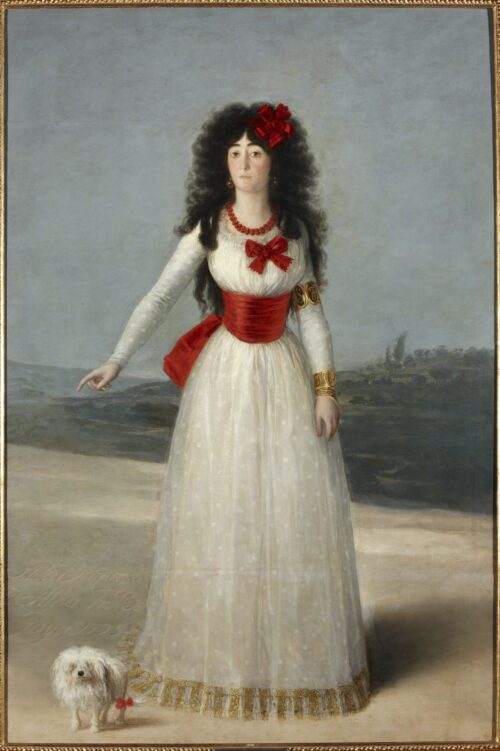
Francisco de Goya y Lucientes (Spanish, 1746–1828). The Duchess of Alba in White, 1795. Oil on canvas, 75 v/8 x 51 iii/16 in. Dukes of Alba Drove, Liria Palace, Madrid
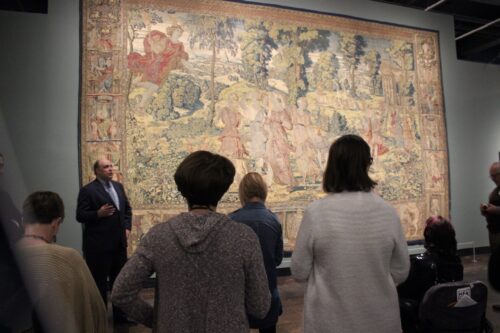
Anthonis Mor (North Netherlandish, 1516/twenty–1575/76). The Grand Knuckles of Alba, 1549. Oil on canvas, 39 iii/4 ten 32 11/sixteen in. Dukes of Alba Collection, Liria Palace, Madrid
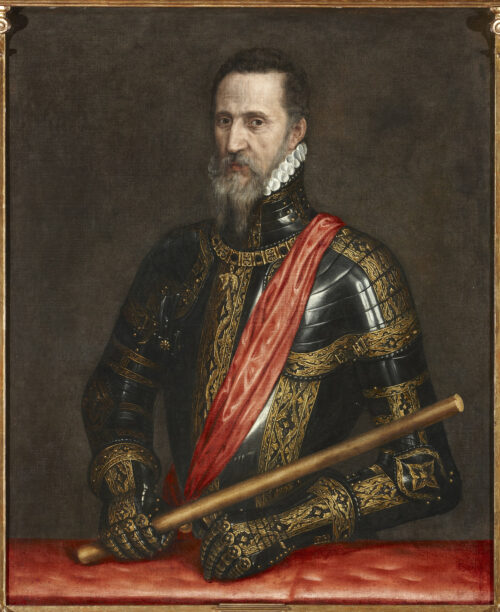
Ignacio Zuloaga y Zabaleta (Spanish, 1870–1945). Portrait of María del Rosario de Silva y Gurtubay, Seventeenth Duchess of Alba, 1921. Oil on canvas, 80 3/8 ten seventy 1/8 in. Dukes of Alba Collection, Liria Palace, Madrid

Christopher Columbus'south logbook of the Voyage of Discovery of the New Globe. Map of La Española, 1492 (?). Paper, covered in parchment, double folio. Dukes of Alba Drove, Columbus Vitrine, Liria Palace, Madrid

Christopher Columbus's logbook of the Voyage of Discovery of the New Globe. Map of La Española (detail), 1492 (?). Newspaper, covered in parchment, double page. Dukes of Alba Collection, Columbus Vitrine, Liria Palace, Madrid
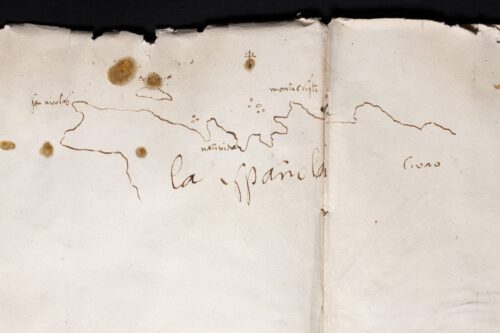
Diego Rodríguez de Silva y Velázquez (Spanish, 1599–1660) and Juan Bautista Martínez del Mazo (Spanish, ca. 1611–1667). The Infanta Margarita, 1653. Oil on canvas, 45 5/16 x 35 7/16 in. Dukes of Alba Drove, Liria Palace, Madrid
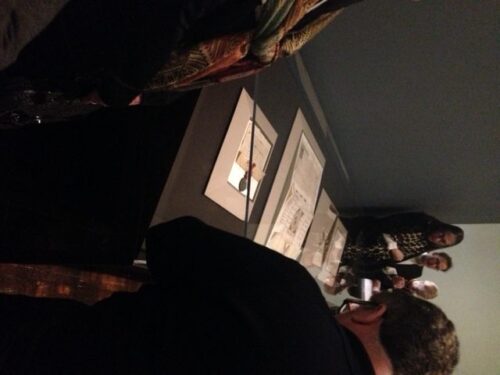
Fernão Vaz Dourado (Portuguese, ca. 1520–ca. 1580). Portulano, Atlas of the World, 1568. Book, vellum, 16 iii/16 10 x i/4 in. Dukes of Alba Drove, Liria Palace, Madrid, Vit. Biblia
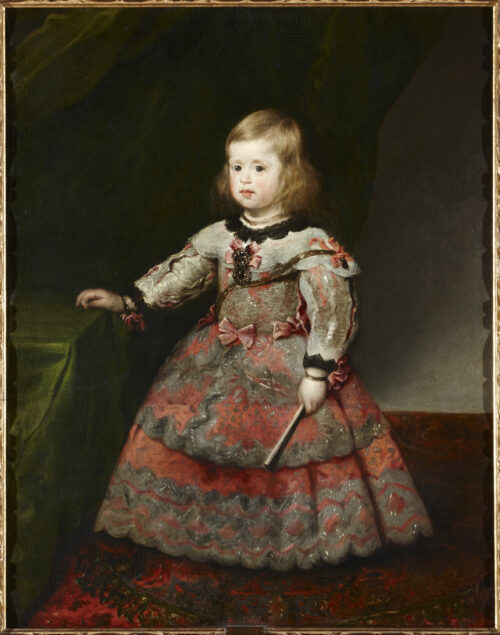
Christopher Columbus'south list of the people who went on his 1492 Journeying of Discovery, 1498. Newspaper, 4 folios, 8 ane/2 10 12 7/16 in. Dukes of Alba Collection, Columbus Vitrine, Liria Palace, Madrid
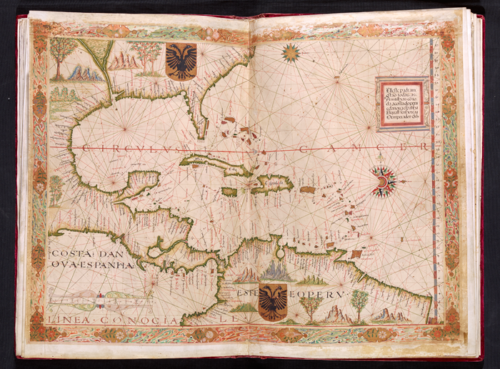
Bartolomé Esteban Murillo (Spanish, 1617–1682). Portrait of Don Juan Antonio de Miranda y Ramírez de Vergara, 1680. Oil on canvass, 77 9/16 ten 42 1/2 in. Dukes of Alba Collection, Liria Palace, Madrid

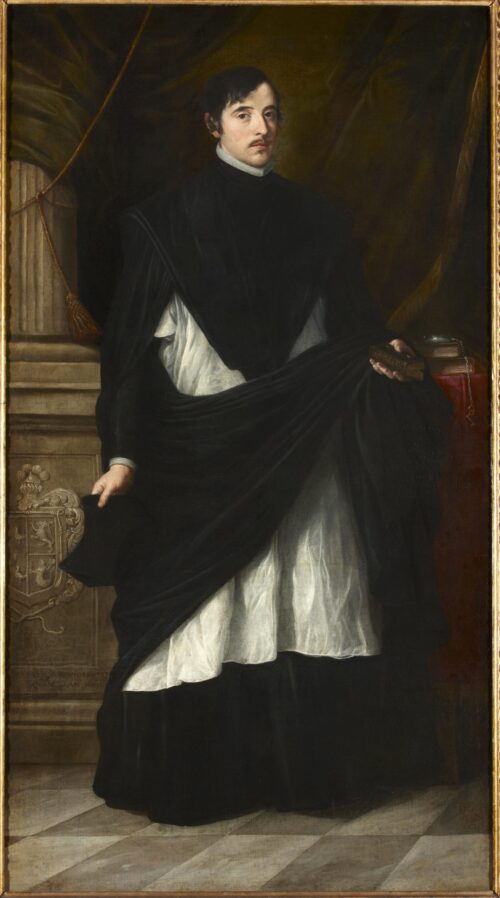
manningbutervirty.blogspot.com
Source: https://fristartmuseum.org/exhibition/treasures-from-the-house-of-alba-500-years-of-art-and-collecting/
Post a Comment for "Treasures From the House of Alba 500 Years of Art and Collecting"